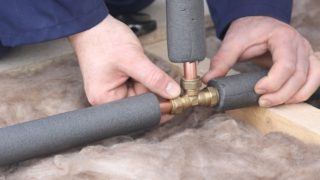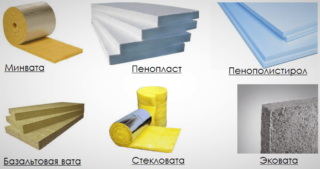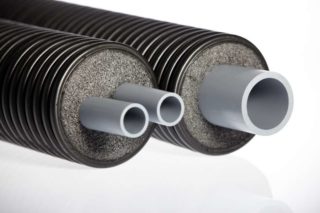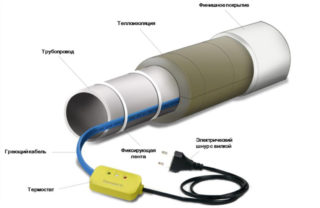So that the autonomous water supply of a country cottage / apartment does not present a surprise in the form of icing of the system in winter, it is advisable to take care of the insulation of the water supply pipes in a private house with your own hands. Only in this case it will be possible to talk about the full-fledged work of communication all year round.
Why insulate water pipes

Uninsulated water supply lines are a number of problems for the owners of the cottage:
- Pipes located at a shallow depth are prone to freezing along with the soil. The water in them will definitely turn into ice in severe frosts.
- The resulting lumps not only stop the operation of the system, which is extremely inconvenient for the family living in the house, but also often lead to a line break.
- An accident requires time-consuming and costly repairs. We have to carry out earthworks, dismantle a section of the pipeline, finance the installation of a new one.
The thermal insulation of the water supply system is especially relevant for residents of cold / northern regions, where the depth of soil freezing is from 1 to 2.5 m or more.
Required tools
To insulate water pipes in the ground at a shallow depth, you should first prepare the following tools and materials:
- the selected type of thermal insulation by footage, in accordance with the length of the line from the well to the entrance to the house;
- hacksaw;
- construction tape;
- shovel;
- bedding of sand and expanded clay;
- metal mesh;
- cement mortar, if expanded polystyrene is used as a heater.
Some types of insulation serve as a warming zone for rodents in winter. Animals make holes in the insulating shell, which forms cold bridges on the highway. Condensation forms from them and further freezing of the line. To prevent this from happening, it is recommended to wind a metal mesh over glass wool or expanded polystyrene and then coat the construction sandwich with a solution of cement with broken glass.
When preparing for work, it is imperative to draw up a schematic drawing of the line indicating the insulation materials used and the location of the main components of the system.
The main methods of pipe insulation
Electric cable
One way to insulate a water line is to use an electric cable. You can use both an external wire and an internal one. The first one is easily assembled with your own hands. Indoor cable requires a professional approach. The technology for laying it is more complicated.
The power consumption of such a wire when heating the line is only 10-20 W / running meter. And the efficiency from it is 100%.
The cable is laid in a spiral with an equal turn pitch. As a rule, it is 10-20 cm, depending on the cross-section of the pipes. The larger it is, the smaller the distance should be. From above, the cable is covered with insulating material, avoiding the formation of cold bridges. The construction sandwich is fixed with foil (shiny) tape.
When using an electric cable, pipes on the water can be laid no deeper than 50 cm from the ground level. But at the same time, you need to monitor the weather. With the coming frosts, it is advisable to connect the wire to the power grid in advance.
Roll thermal insulation materials

Mineral wool, polyethylene foam "Energoflex" or glass wool are the cheapest options for insulation. They tend to absorb moisture and lose their airy structure over time. Alternatively, some craftsmen additionally cover the cotton wool on top with rolls of oilcloth. And if you still shell out, you can use a metal casing. It will act as a protective upper shell.
Water pipes are insulated with cotton wool using the following technology:
- The line is tightly wrapped with heat-insulating material so that there are no gaps. Rolls of mineral wool are fastened with steel wire.
- From above they are wrapped in dense polyethylene, fixing all this with tape in a spiral.
- It remains to backfill the line.
To prevent the water from freezing in the pipes at the outlet of the well, it is advisable to build an insulated caisson.
Creation of an air gap
This method involves the use of another larger diameter hollow pipe. A water supply line is placed in it in such a way that an air gap is formed in the difference in cross-sections. It will serve as a frost protection for the water supply. Due to the free circulation of air in this area, the water in the line will not freeze.
Styrofoam or Styrofoam shell
Such insulating elements are in the form of whole or split cylinders. The material has the following advantages:
- Density. The insulation will not sag under the influence of static soil pressure.
- Low (zero) percentage of water absorption. The shell does not absorb moisture, does not rot, which means that it perfectly retains its thermal insulation properties.
- Affordability.
- Relative ease of installation.
Put a split shell on the pipes in this way:
- Arrange the bottom of the material, then the top.
- All joints are carefully coated with adhesive. The two parts of the shell should be squeezed for a while so that the glue adheres well. This is required by the technology of insulating a water supply system from HDPE pipes in the ground.
- Subsequent cylinder segments must be mounted with a horizontal joint offset relative to each previous one. This will reduce the number of cold bridges.
When buying thermal insulation in the form of cylinders, you need to accurately select them according to the inner diameter. It must match the outer section of the pipe. Sagging and voids are excluded.
Factory finished pipe

This method of insulation is considered one of the most expensive. The manufacturer offers the master ready-made tubes equipped with heat-insulating material. Structurally, this is one main plastic / polyethylene pipe, wrapped with insulation and placed in another (larger in diameter). It remains only to properly lay them in the trench.
If the house is not used in winter, the system can be protected by simply draining the water from it. Sometimes craftsmen resort to a radically different solution - keep the tap constantly open to a minimum. Slow circulation of water in the line prevents the line from freezing. But this method is costly. We'll have to give all the best for utility bills.
Criteria for choosing insulation material and requirements for it
The main requirements for good thermal insulation are as follows:
- durability and resistance to chemical / biological environments;
- minimum moisture absorption coefficient;
- low level of thermal conductivity, high heat-saving properties;
- resistance to mechanical / static stress;
- the ability to operate the material at different temperature indicators.
Extruded polystyrene foam, electric cable, heat-insulating paint, foam in the form of cylinders meet these requirements.
In general, you need to choose a heater for water pipes according to the following criteria:
- family budget;
- type of pipe material: electric cable or heat-insulating paint are good for metal; for HDPE tubes, it is better to take a polystyrene foam shell;
- laboriousness of the future process of warming;
- durability of insulation: cylindrical segments of "Penoplex" or finished factory pipes with insulation are considered promising.
Thermal insulation material against freezing of the line should be purchased with a small margin. This will eliminate downtime and provide reliable, complete insulation.
Tips from the masters
When performing installation work in the country or in a country private house, be sure to pay attention to connections and fittings. They need better processing. If this moment is missed, condensation moisture will eventually become the number one problem. Places of threaded joints will ice first and then disable the entire system.
Insulation is also required by pipes located in unheated rooms (basement, cellar, etc.). It is best to use merylon here.
Do not forget about those areas of the pipeline that are at the entrance to the house. Here, temperature drops - heat from the basement and cold from the street - are also unfavorable conditions for the normal functioning of the water supply system in frosty weather. The entry in the foundation area can also be insulated with merylon.
A well-arranged water supply system will not cause trouble for the owner of the house and will provide all residents with an uninterrupted supply of water.









